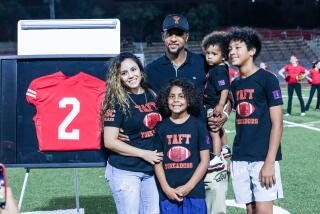The Duke of Compton
- Share via
High school sports serve as a rite of passage for the athletes who play them, the student, friends and families that gather to watch them and the sportswriters who cut their professional teeth covering them.
High school football games in Los Angeles date to 1896, but it wasn’t until 1934 that the Los Angeles City Section was born.
The Southern Section was established in 1912 and held its first athletic competition in 1913.
This story is not an attempt to document the achievements of every outstanding athlete, coach and team that made a mark, for there are far too many to chronicle here.
Rather, it is a history lesson of sorts told by current and former Times staff writers who have written about Southland prep athletes. Most of the writers graduated from Los Angeles-area high schools. And while many have gone on to cover college and professional sports as beat writers or columnists, all maintain indelible images of the prep athletes they watched, covered and, in some instances, competed with and against on the playing field.
*
As a senior at Beverly Hills High, I played on a very average Norman football team. We did, however, beat Compton, which had a quarterback named Duke Snider.
Many years later, I ran into Snider at Dodger Stadium and reminded him of our victory over Compton. He was still irritated by the loss, more so when he learned that I was an opposing halfback. Losing to a future sportswriter made it even more galling.
It was during that era that a young sprinter from nearby University High was receiving acclaim. His name was Mel Patton, the future world’s fastest human, who would set world records in the sprints and win the gold medal at 200 meters in the 1948 Olympic Games in London.
During the 1942 football season, Glenn Davis, who would become the 1946 Heisman Trophy winner, was running wild for La Verne Bonita. Also, in the mid-1940s a halfback from Washington High was drawing considerable attention: Hugh McElhenny. He would go on to play for the University of Washington and San Francisco 49ers and was voted into the NFL Hall of Fame.
McElhenny was one of the most exciting runners I’ve ever seen. He had sprinter’s speed--he was the city champion in the low and high hurdles in 1947--with an amazing ability to change direction.
In that same era, there was a gifted running back, gymnast and long jumper at Manual Arts named Jon Arnett, who later played for USC, the Rams and Chicago Bears.
Arnett, who played for legendary Manual Arts Coach Jim Blewett, used his gymnastics training to great effectiveness on the football field. He would get hit, spin in the air and then land in a tripod fashion, his knees never touching the ground, and keep running.
More to Read
Go beyond the scoreboard
Get the latest on L.A.'s teams in the daily Sports Report newsletter.
You may occasionally receive promotional content from the Los Angeles Times.










